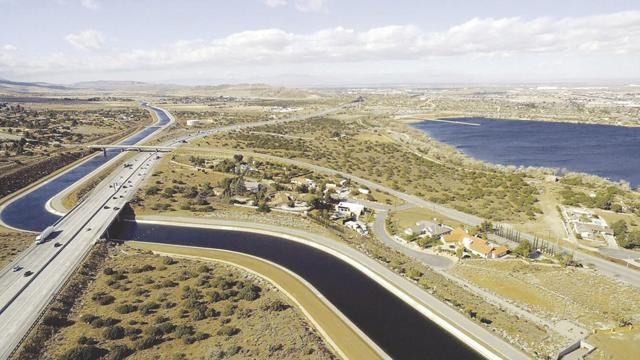From the AV Press: Water Providers Looking into Other Sources for Customers
PALMDALE — Area water providers are looking to their reserves and other sources for water next year, as they can not expect to receive supplies from the State Water Project.

In light of continuing drought conditions, the state Department of Water Resources announced this week that contractors can expect 0% of their allocations next year.
“The 0% allocation doesn’t come as a shock,” said Dwayne Chisam, general manager of the Antelope Valley-East Kern Water Agency.
The 2021 allocation was also greatly diminished due to drought conditions, to 5%.
AVEK is the largest of the three state water contractors in the Valley. It provides supplemental supplies to retail water providers, such as Quartz Hill Water District and Los Angeles County Waterworks District 40.
Over the past 10 years, the Agency has been developing and using water banking to store reserve supplies under ground. During the wet years between 2017 and 2019, AVEK was able to store close to 100,000 acre-feet of water for use during dry years, Chisam said.
An acre-foot is 325,851 gallons, or approximately the amount of water a typical Antelope Valley household used in one year before recent droughts reduced usage.
The agency tapped into those banked reserves to make up for shortages in 2021, and plans to use about 20,000 to 25,000 acre-feet of the remaining approximately 70,000 acre-feet next year to meet demands next year, Chisam said.
AVEK officials predict the demand for their water will be about 42,000 acre-feet next year, without accounting for the existing voluntary 15% conservation request from the governor.
Palmdale Water District is also a state water contractor. State Water Project water makes up about half of its supplies in an average year, along with groundwater and runoff collected in the reservoir behind the Littlerock Dam.
In 2021, the District was able to use water dedicated to it from previous exchanges with other providers, as well as somewhat increased groundwater pumping and moderate conservation by its customers, Resource and Analytics Director Peter Thompson II said.
“We still had a gap of close to 3,000 acre-feet,” he said, which required purchasing water from another State Water Project contractor, at an extra cost to the District.
In planning for 2022, the District is evaluating the supply and demand sides of the equation.
“With a zero allocation, it really makes it much more likely that we will end up having some sort of mandatory conservation in 2022,” Thompson said.
Unlike AVEK, the District does not have access to banked reserves. However, it does have a sort of virtual water bank in the form of water owed them from previous exchanges with other contractors, he said.
The problem with that: because so little water is available, those other contractors may not have the water to give, he said.
The 0% is an initial allocation; the number may change if weather conditions improve.
“I definitely hold out a lot of hope for that,” Thompson said, with the wettest months traditionally in January and February.
However, even if the state sees average levels of precipitation, it won’t be enough to bring water deliveries up to normal levels, because the reservoirs “are significantly behind their averages for this time of year. We have to make up a lot of supply in those reservoirs,” he said.
The 0% allocation does not mean the State Water Project will not release any water to contractors. The Department of Water Resources will provide water for health and safety purposes.
The Department uses a formula to determine the minimum amount of water required for health and safety of residents, which amounts to 55 gallons per capita per day, Chisam said.
This basically accounts for minimum indoor use only, not landscape irrigation or similar uses.
Because of its reserves, AVEK only needs about a 20% allocation to meet all of its customer demands, Chisam said.
“Staff’s working pretty hard to be able to make sure that we have those supplies available during those peak summer months when we need them the most,” he said.
While area water providers have reserves and other methods to continue to meet demands this year, the cushion is small, and the threat of continued drought is there.
“If we have another dry year, it’s going to be very tough on everyone in the state,” Chisam said.
AVEK and PWD, along with the area’s third contractor, the Littlerock Creek Irrigation District, form the Antelope Valley State Water Contractors Association, which works collaboratively to support and develop projects and programs to maximize use of State Water Project water, when it is available, said Thompson, who also serves as the general manager for the Association.
For example, the Association is in the midst of a feasibility study for groundwater recharge near Big Rock Creek on the Valley’s east side.
“Times like this, where you have these intense drought cycles, really speak to the importance of that collaborative purpose to work together to find solutions to bring more water into the AV,” he said.
The individual agencies are also working to increase storage and supplies.
AVEK has another water bank in development, the High Desert Water Bank, which is expected to have a partial startup in 2023, and be completed in 2024-2025, Chisam said.
Palmdale Water District is also looking at ways to increase storage for the future through banking, maximizing use of recycled water and increasing capacity behind Littlerock Dam with an ongoing silt removal project.
Conservation is also important to decrease the demand, Thompson said.
“Every gallon that they save is a gallon … I get to carry over for 2022,” he said.

